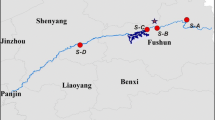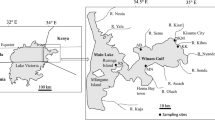Abstract
This study assessed the contamination extent and potential ecological and human health impacts for chromium (Cr), manganese (Mn), nickel (Ni), copper (Cu), zinc (Zn), cadmium (Cd), and lead (Pb) in sediments and indigenous benthic organisms along the coastal area of Huludao, China. We analyzed a total of eight species: two benthic fish species, two bivalves, two snails, and two decapod crustaceans. Cu, Zn, and Cd levels in sediment exceeded the Chinese marine sediment quality criteria. The geoaccumulation index was highest for Cd followed in a decreasing order by Zn, Pb, Cu, Ni, and Cr. Metal levels were highest in the four mollusk species. The oyster and veined rapa whelk had the highest bioaccumulation factors, indicating that these two species would be well suited for monitoring the metal pollution in this area. Our comparison of estimated daily intake values for human consumption of the seafood species to the Food and Agricultural Organization-recommended daily dietary allowances indicate potential health risks from the intake of Cd from all shellfish other than our crab species and Zn intake from oyster consumption. An analysis of target hazard quotients identified noncarcinogenic health risks from Cd (in all shellfish analyzed except for our crab species), Cu, and Zn (in oysters and veined rapa whelks). Moreover, an analysis of cancer risk from Pb ingestion detected an increased risk for consumption of all shellfish except for the crab species. Health risks seem especially pronounced for the consumption of oysters and the veined rapa whelks; a seafood advisory may be warranted for these mollusks.


Similar content being viewed by others
References
Allan R (1997) Introduction: mining and metals in the environment. J Geochem Explor 58:95–100
Bakulski KM et al (2014) Lead exposure, B vitamins, and plasma homocysteine in men 55 years of age and older: the VA Normative Aging Study. Environ Health Perspect 122:1066–1074
Beliaeff B, O’Connor TP, Claisse D (1998) Comparison of chemical concentrations in mussels and oysters from the United States and France. Environ Monit Assess 49:87–95
Bragigand V, Berthet B, Amiard JC, Rainbow PS (2004) Estimates of trace metal bioavailability to humans ingesting contaminated oysters. Food Chem Toxicol 42:1893–1902
Bryan GW (1968) Concentrations of zinc and copper in the tissues of decapod crustaceans. J Mar Biol Assoc UK 48:303
Chen MH, Chen CY (1999) Bioaccumulation of sediment-bound heavy metals in grey mullet, Liza macrolepis. Mar Pollut Bull 39:239–244
Copat C, Bella F, Castaing M, Fallico R, Sciacca S, Ferrante M (2012) Heavy metals concentrations in fish from Sicily (Mediterranean Sea) and evaluation of possible health risks to consumers. Bull Environ Contam Toxicol 88:78–83
Cui BS, Zhang QJ, Zhang KJ, Liu XH, Zhang HG (2011) Analyzing trophic transfer of heavy metals for food webs in the newly-formed wetlands of the Yellow River Delta, China. Environ Pollut 159:1297–1306
de Astudillo LR, Yen IC, Agard J, Bekele I, Hubbard R (2002) Heavy metals in green mussel (Perna viridis) and oysters (Crassostrea sp.) from Trinidad and Venezuela. Arch Environ Contam Toxicol 42:410–415
Diaz S, Martin-Gonzalez A, Gutierrez JC (2006) Evaluation of heavy metal acute toxicity and bioaccumulation in soil ciliated protozoa. Environ Int 32:711–717
Feng HA et al (2011) Metal contamination in sediments of the western Bohai Bay and adjacent estuaries, China. J Environ Manag 92:1185–1197
Fishbein L (1981) Sources, transport and alterations of metal compounds—an overview. 1. Arsenic, beryllium, cadmium, chromium, and nickel. Environ Health Perspect 40:43–64
Fu JJ et al (2013) Influence of e-waste dismantling and its regulations: temporal trend, spatial distribution of heavy metals in rice grains, and its potential health risk. Environ Sci Technol 47:7437–7445
Gao XL, Chen CTA (2012) Heavy metal pollution status in surface sediments of the coastal Bohai Bay. Water Res 46:1901–1911
Gao X, Zhou F, Chen C-TA (2014) Pollution status of the Bohai Sea: an overview of the environmental quality assessment related trace metals. Environ Int 62:12–30
Hakanson L (1980) An ecological risk index for aquatic pollution control—a sedimentological approach. Water Res 14:975–1001
Hare L, Tessier A, Borgmann U (2003) Metal sources for freshwater invertebrates: pertinence for risk assessment. Hum Ecol Risk Assess 9:779–793
Hu BQ, Li J, Zhao JT, Yang J, Bai FL, Dou YG (2013) Heavy metal in surface sediments of the Liaodong Bay, Bohai Sea: distribution, contamination, and sources. Environ Monit Assess 185:5071–5083
Joint FAO/WHO Expert Committee on Food Additives (1982) Evaluation of certain food additives and contaminants. Twenty-sixth report of the Joint FAO/WHO Expert Committee on Food Additives. WHO technical report series no. 683. WHO, Geneva
Joint FAO/WHO Expert Committee on Food Additives (1989) Evaluation of certain food additives and contaminants. Twenty-sixth report of the joint FAO/WHO Expert Committee on Food Additives. WHO technical report series no. 776. WHO, Geneva
Joint FAO/WHO Expert Committee on Food Additives (2000) Evaluation of certain food additives and contaminants. Twenty-sixth report of the joint FAO/WHO Expert Committee on Food Additives. WHO technical report series no. 896. WHO, Geneva
Kimbrough KL, Lauenstein G, Christensen J, Apeti D (2008) An assessment of two decades of contaminant monitoring in the nation’s coastal zone. NOAA/National Centers for Coastal Ocean Science, Silver Spring
Liang LN, He B, Jiang GB, Chen DY, Yao ZW (2004) Evaluation of mollusks as biomonitors to investigate heavy metal contaminations along the Chinese Bohai Sea. Sci Total Environ 324:105–113
Menezes JA, Viana GFD, Paes CR (2012) Determinants of lead exposure in children on the outskirts of Salvador, Brazil. Environ Monit Assess 184:2593–2603
Müller G (1979) Schwermetalle in den Sedimenten des Rheins-Veränderungen seit. Umschau 79:778–783
Müller G (1981) Die Schwermetallbelastung der Sedimente des Neckars und seiner Nebenflusse: Eine Bestandsaufnahme. Chemiker Zeitung 105:157–164
Nadal M, Ferre-Huguet N, Marti-Cid R, Schuhmacher M, Domingo JL (2008) Exposure to metals through the consumption of fish and seafood by the population living near the Ebro River in Catalonia, Spain: Health risks. Hum Ecol Risk Assess 14:780–795
National Research Council (1989) National Research Council recommended dietary allowances, 10th edn. National Academy of Sciences, Washington, DC, pp 241–243
Pan K, Wang WX (2012) Trace metal contamination in estuarine and coastal environments in China. Sci Total Environ 421:3–16
Rainbow PS, Smith BD (2010) Trophic transfer of trace metals: subcellular compartmentalisation in bivalve prey and comparative assimilation efficiencies of two invertebrate predators. J Exp Mar Biol Ecol 390:143–148
Szebedinszky C, McGeer JC, McDonald DG, Wood CM (2001) Effects of chronic Cd exposure via the diet or water on internal organ-specific distribution and subsequent gill Cd uptake kinetics in juvenile rainbow trout (Oncorhynchus mykiss). Environ Toxicol Chem 20:597–607
Thiyagarajan D, Dhaneesh KV, Kumar TTA, Kumaresan S, Balasubramanian T (2012) Metals in fish along the southeast coast of India. Bull Environ Contam Toxicol 88:582–588
United States Environmental Protection Agency (USEPA) (1989) Risk assessment guidance for superfund. Volume I. Human health evaluation manual (Part A), Interim final. EPA 540/1–89/002. United States Environmental Protection Agency, Washington, DC
United States Environmental Protection Agency (USEPA) (2000) Guidance for assessing chemical contamination data for use in fish advisories. Volume II. Risk assessment and fish consumption limits. EPA/823-B94-004. United States Environmental Protection Agency, Washington, DC
United States Environmental Protection Agency (USEPA) (2007) Concepts, methods and data sources for cumulative health risk assessment of multiple chemicals, exposures and effects: A resource document; EPA/600/R-06/013F. National Center for Environmental Assessment, Office of Research and Development, United States Environmental Protection Agency, Cincinnati
United States Environmental Protection Agency (USEPA) (2010) Risk-based concentration table. http://www.epa.gov/reg3hwmd/risk/human/index.htm
Valavanidis A, Vlahogianni T, Dassenakis M, Scoullos M (2006) Molecular biomarkers of oxidative stress in aquatic organisms in relation to toxic environmental pollutants. Ecotoxicol Environ Saf 64:178–189
Vallee BL (1959) Biochemistry, physiology and pathology of zinc. Physiol Rev 39:443–490
Vieira C, Morais S, Ramos S, Delerue-Matos C, Oliveira MBPP (2011) Mercury, cadmium, lead and arsenic levels in three pelagic fish species from the Atlantic Ocean: intra- and inter-specific variability and human health risks for consumption. Food Chem Toxicol 49:923–932
Vodopivez C, Curtosi A, Villaamil E, Smichowski P, Pelletier E, Mac Cormack WP (2015) Heavy metals in sediments and soft tissues of the Antarctic clam Laternula elliptica: more evidence as a possible biomonitor of coastal marine pollution at high latitudes? Sci Total Environ 502:375–384
Wang WX, Fisher NS (1999) Assimilation efficiencies of chemical contaminants in aquatic invertebrates: a synthesis. Environ Toxicol Chem 18:2034–2045
Wang YW, Liang L, Shi JB, Jiang GB (2005) Study on the contamination of heavy metals and their correlations in mollusks collected from coastal sites along the Chinese Bohai Sea. Environ Int 31:1103–1113
Wang J, Chen S, Xia T (2010) Environmental risk assessment of heavy metals in Bohai Sea, North China. Procedia Environ Sci 2:1632–1642
WHO (1996) Guidelines for drinking water quality, vol 2, 2nd edn. World Health Organization, Geneva
Zhang ZH, Zhu MY, Wang ZL, Wang J (2006) Monitoring and managing pollution load in Bohai Sea, PR China. Ocean Coast Manag 49:706–716
Zheng N, Wang QC, Zhang XW, Zheng DM, Zhang ZS, Zhang SQ (2007a) Population health risk due to dietary intake of heavy metals in the industrial area of Huludao city, China. Sci Total Environ 387:96–104
Zheng N, Wang QC, Zheng DM (2007b) Health risk of Hg, Pb, Cd, Zn, and Cu to the inhabitants around Huludao zinc plant in china via consumption of vegetables. Sci Total Environ 383:81–89
Zheng N, Wang QC, Liang ZZ, Zheng DM (2008) Characterization of heavy metal concentrations in the sediments of three freshwater rivers in Huludao City, Northeast China. Environ Pollut 154:135–142
Zhou F, Guo HC, Hao ZJ (2007) Spatial distribution of heavy metals in Hong Kong’s marine sediments and their human impacts: a GIS-based chemometric approach. Mar Pollut Bull 54:1372–1384
Acknowledgments
The authors thank Professor Peiwen Liang from the South China Sea Fishery Research Institute and Fangcan Chen from the Pearl River Fisheries Research Institute, Chinese Academy of Fishery Sciences, for their help with species identification. This work was financially supported by National Natural Science Foundation of China Grant (NSFC Nos. 31270549 and 41303087) and the One-Hundred Talent program of the Chinese Academy of Sciences to L. Xie.
Author information
Authors and Affiliations
Corresponding author
Rights and permissions
About this article
Cite this article
Gao, M., Klerks, P.L., Wu, X. et al. Metal Concentrations in Sediment And Biota of the Huludao Coast in Liaodong Bay and Associated Human and Ecological Health Risks. Arch Environ Contam Toxicol 71, 87–96 (2016). https://doi.org/10.1007/s00244-016-0274-8
Received:
Accepted:
Published:
Issue Date:
DOI: https://doi.org/10.1007/s00244-016-0274-8




